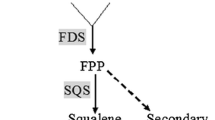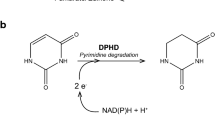Abstract
Oligonucleotides, designed on the basis of conserved flanking amino acid sequence segments within the catalytic domain of eukaryotic protein kinase C (PKC) proteins, were used as primers for polymerase chain reactions to amplify a 427-bp chromosomal DNA fragment from the filamentous fungusTrichoderma reesei. This fragment was then used to isolate genes encoding PKC homologues ofT. reesei andAspergillus niger (pkcl andpkcA, respectively). The genes contain six (T. reesei) and eight (A. niger) introns, which exhibit notable conservation in position with those found in the correspondingSchizosaccharomyces pombe pkc1 + andDrosophila melanogaster dPKC53Ebr genes. A single 4.2-kb transcript was detected in Northern analyses. The deduced PKC1 (T. reesei, 126 kDa) andPKCA (A. niger, 122 kDa) amino acid sequences reveal domains homologous to the Cl and C3/C4 domains of PKC-related proteins, but lack typical Ca2+-binding (C2) domains. Both contain a large, extended N-terminus, which shares a high degree of similarity with the corresponding regions ofSaccharomyces cerevisiae PKC1 andS. pombe pkc1+ and pkc2+ proteins, but which is not present in PKCs ofDictyostelium or higher eukaryotes. This extended region can be divided into three subdomains; the N-terminal one contains a hydrophobic helix-turn-helix motif, whereas the C-terminal one contains potential targets for proteolytic processing. A polyclonal antiserum raised against the pseudosubstrate-binding domain of PKC1 recognizes inT. reesei a 115–120 kDa protein in Western blots. Expression ofpkc1 cDNA in insect cells directs the synthesis of a PKC1 protein of similar size. TheT. reesei PKC1 protein was partially purified and some of its properties examined: it is stimulated about twofold by phospholipids or phorbol esters but is not stimulated by Ca2+. We conclude that these PKC proteins from filamentous fungi represent the Ca2+-insensitive fungal homologues of the nPKC family.
Similar content being viewed by others
References
Akimoto K, Mizuno K, Osada S, Hirai S, Tanuma S, Suzuki K, Ohno S (1994) A new member of the third class in the protein kinase C family, PKC-lambda, expressed dominantly in an undifferentiated mouse embryonal cell line, and also in many tissues and cells. J Biol Chem 269:12677–12683
Antonsson B, Montessuit S, Friedli L, Payton MA, Paravicini G (1994) Protein kinase C in yeast. Characteristics of theSaccharomyces cerevisiae PKC1 gene product. J Biol Chem 269: 16821–16828
Azzi A, Boscoboinik D, Hensey C (1992) The protein kinase C family. Eur J Biochem 208:547–557
Burns DJ, Bell RM (1991) Protein kinase C contains two phorbol ester binding domains. J Biol Chem 266:18330–18338
Chirgwin JM, Przybyla AE, MacDonald RJ, Rutter WJ (1979) Isolation of ribonucleic acid from sources enriched in ribonuclease. Biochemistry 18:5294–5299
Courey AJ, Tijan R (1988) Analysis of Sp1in vivo reveals multiple transcriptional domains, including a novel glutamine-rich activation motif. Cell 55: 887–898
Favre B, Turian G (1987) Identification of a calcium- and phospholipid-dependent protein kinase (protein kinase C) inNeurospora crassa. Plant Sci 49:15–21
Goodnight J, Kazanietz MG, Blumberg PM, Mushinsky JF, Mischak H (1992) The cDNA sequence, expression pattern and protein characteristics of mouse protein kinase C-zeta. Gene 122:305–311
Gruber F, Visser J, Kubicek CP, De Graaff L (1990a) The development of a heterologous transformation system for the cellulolytic fungusTrichoderma reesei based on apyr4-negative mutant strain. Curr Genet 18:447–451
Gruber F, Visser J, Kubicek CP, De Graaff L (1990b) Cloning of theTrichoderma reesei pyr4 gene and its use as a homologous marker for a high-frequency transformation system. Curr Genet 18:71–76
Gschwendt M, Kittstein W, Marks F (1991) Protein kinase C activation by phorbol esters: do cysteine-rich regions and pseudosubstrate motifs play a role? Trends Biochem Sci 16:167–169
Hanks SK, Quinn AM, Hunter T (1988) The protein kinase C family: conserved features and deduced phylogeny of the catalytic domains. Science 241:42–52
Harmsen JAM, Kusters-van Someren MA, Visser J (1990) Cloning and expression of a secondAspergillus niger pectin lyase gene (pelA): indication of a pectin lyase gene family inA. niger. Curr Genet 18:161–166
House C, Kemp BE (1987) Protein kinase C contains a pseudosubstrate prototype in its regulatory domain. Science 238: 1726–1728
Johannes F-J, Prestle J, Eis S, Oberhagemann P, Pfizenmayer K (1994) PKCμ: a novel, atypical member of the protein kinase C family. J Biol Chem 269:6140–6148
Kazanietz MG, Areces LB, Bahador AD, Mischak H, Goodnight J, Mushinski JF, Blumberg PM (1993) Characterization of ligand and substrate specificity for the calcium-dependent and calcium-independent protein kinase C isoenzymes. Mol Pharmacol 44:298–307
Kikkawa U, Takai Y, Minaguchi R, Inohara S, Nishizuka Y (1982) Calcium-activated, phospholipid-dependent protein kinase from rat brain. J Biol Chem 257:13341–13348
Kishimoto A, Mikawa K, Hashimoto K, Yasuda I, Tanaka S-I, Tominaga M, Kuroda T, Nishizuka Y (1989) Limited proteolysis of protein kinase C subspecies by calcium-dependent neutral protease. J Biol Chem 264:4088–4092
Knopf JL, Lee H-M, Sultzmann LA, Kriz WR, Loomis CR, Hewick RM, Bell RM (1986) Cloning and expression of multiple protein kinase C cDNAs. Cell 46:491–502
Laemmli UK (1970) Cleavage of structural proteins during the assembly of the head of bacteriophage T4. Nature 227:680–685
Lamb CJ (1994) Plant disease resistance genes in signal perception and transduction. Cell 76:419–422
Levin DE, Fields FO, Kunisawa R, Bishop JM, Thorner J (1990) A candidate protein kinase C gene, PKC1, is required for theSaccharomyces cerevisiae cell cycle. Cell 62:213–224
Magae Y (1993) Purification and characterization of protein kinase C fromPleurotus ostreatus. J Gen Microbiol 139:165–169
Malviya AN, Block C (1993) Nuclear protein kinase C and signal transduction. Receptor 3:257–275
Mandels M, Andreotti RE (1978) The cellulose to cellulase fermentation. Proc Biochem 13:6–13
Mazzei GJ, Schmid EM, Knowles JKC, Payton MA, Maundrell KG (1993) A Ca2+-independent protein kinase C from fission yeast. J Biol Chem 268:7401–7406
Mischak H, Bodenteich A, Kolch W, Goodnight J, Hofer F, Mushinski JF (1991) Mouse protein kinase C-δ, the major isoform expressed in mouse hemopoietic cells: the sequence of the cDNA, expression patterns, and characterization of the protein. Biochemistry 30: 7925–7931
Morawetz R, Lendenfeld T, Mischak H, Goodnight J, Mushinski JF, Kubicek CP (1994) A protein kinase-encoding gene,pkt1, fromTrichoderma reesei, homologous to the yeastYPK1 andYPK2(YKP)2 genes. Gene 146:309–310
Nishizuka Y (1988) The molecular heterogeneity of protein kinase C and implications of cellular regulation. Nature 334:661–665
Ogita K, Miyamoto SI, Koide H, Iwai T, Oka M, Ando K, Kishimoto A, Ikeda K, Fukami Y, Nishizuka Y (1990) Protein kinase C inSaccharomyces cerevisiae: comparison with the mammalian enzyme. Proc Natl Acad Sci USA 87:5011–5015
Ohno S, Akita Y, Konno Y, Imajoh S, Suzuki K (1988) A novel phorbol ester receptor/protein kinase, nPKC, distantly related to the protein kinase C family. Cell 53:731–741
Ono Y, Fujii T, Ogita K, Kikkawa U, Igarashi K, Nishizuka Y (1988) The structure, expression and properties of additional members of the protein kinase C family. J Biol Chem 263: 6927–6932
Osada S-I, Mizuno K, Saido TC, Akita Y, Suzuki K, Kuroki T, Ohno S (1990) Phorbol ester receptor/protein kinase, nPKCn, a new member of the protein kinase C family predominantly expressed in lung and skin. J Biol Chem 265:22434–22440
Osada S-I, Mizuno K, Saido TC, Suzuki K, Kuroki T, Ohno S (1992) A new member of the protein kinase C family, nPKC, predominantly expressed in skeletal muscle. Mol Cell Biol 12:3930–3938
Ravid S, Spudich JA (1992) Membrane-boundDictyostelium heavy chain kinase: a developmentally regulated substrate-specific member of the protein kinase C family. Proc Natl Acad Sci USA 89:5877–5881
Rosenthal A, Rhee L, Yadegari R, Paro R, Ullrich A, Goeddel DV (1987) Structure and nucleotide sequence of aDrosophila melanogaster protein kinase C gene. EMBO J 6:433–441
Sambrook J, Fritsch EF, Maniatis T (1989) Molecular cloning: a laboratory manual. Cold Spring Harbor Laboratory Press, Cold Spring Harbor, N.Y.
Schaeffer E, Smith D, Mardon G, Quinn W, Zuker C (1989) Isolation and characterization of two newDrosophila protein kinase C genes, including one specifically expressed in photoreceptor cells. Cell 57:403–412
Selbie LA, Schmitz-Pfeiffer C, Sheng Y, Biden TJ (1993) Molecular cloning and characterization of PKC-t, an atypical isoform of protein kinase C derived from insulin secreting cells. J Biol Chem 268:24296–24302
Sossin WS, Schwartz JH (1993) Ca2+-independent protein kinase Cs contain an aminoterminal domain similar to the C2 consensus sequence. Trends Biochem Sci 18:207–208
Stellwagen E (1990) Chromatography on immobilized reactive dyes. Methods Enzymol 184:343–357
Tabuse Y, Nishiwaki N, Miwa J (1989) Mutations in a protein kinase C homolog confer phorbol ester resistance onCaenorhabditis elegans. Science 243:1713–1716
Toda T, Shimanuki M, Yanagida M (1993) Two novel protein kinase C-related genes of fission yeast are essential for cell viability and implicated in cell shape control. EMBO J 12:1987–1995
Von Heijne G (1986) A new method for predicting signal sequence cleavage sites. Nucleic Acids Res 14:4683–4690
Watanabe M, Chen C-Y, Levin DE (1994)Saccharomyces cerevisiae PKC1 encodes a protein kinase (PKC) homolog with a substrate specificity similar to that of mammalian PKC. J Biol Chem 269:16829–16836
Witteveen CFB, Busink R, Van de Vondervvort P, Dijkema C, Swart K, Visser J (1989) L-arabinose and D-xylose catabolism inAspergillus niger. J Gen Microbiol 135:2163–2171
Author information
Authors and Affiliations
Additional information
Communicated by C. A. M. J. J. van den Hondel
Rights and permissions
About this article
Cite this article
Morawetz, R., Lendenfeld, T., Mischak, H. et al. Cloning and characterisation of genes (pkc1 andpkcA) encoding protein kinase C homologues fromTrichoderma reesei andAspergillus niger . Molec. Gen. Genet. 250, 17–28 (1996). https://doi.org/10.1007/BF02191821
Received:
Accepted:
Issue Date:
DOI: https://doi.org/10.1007/BF02191821




